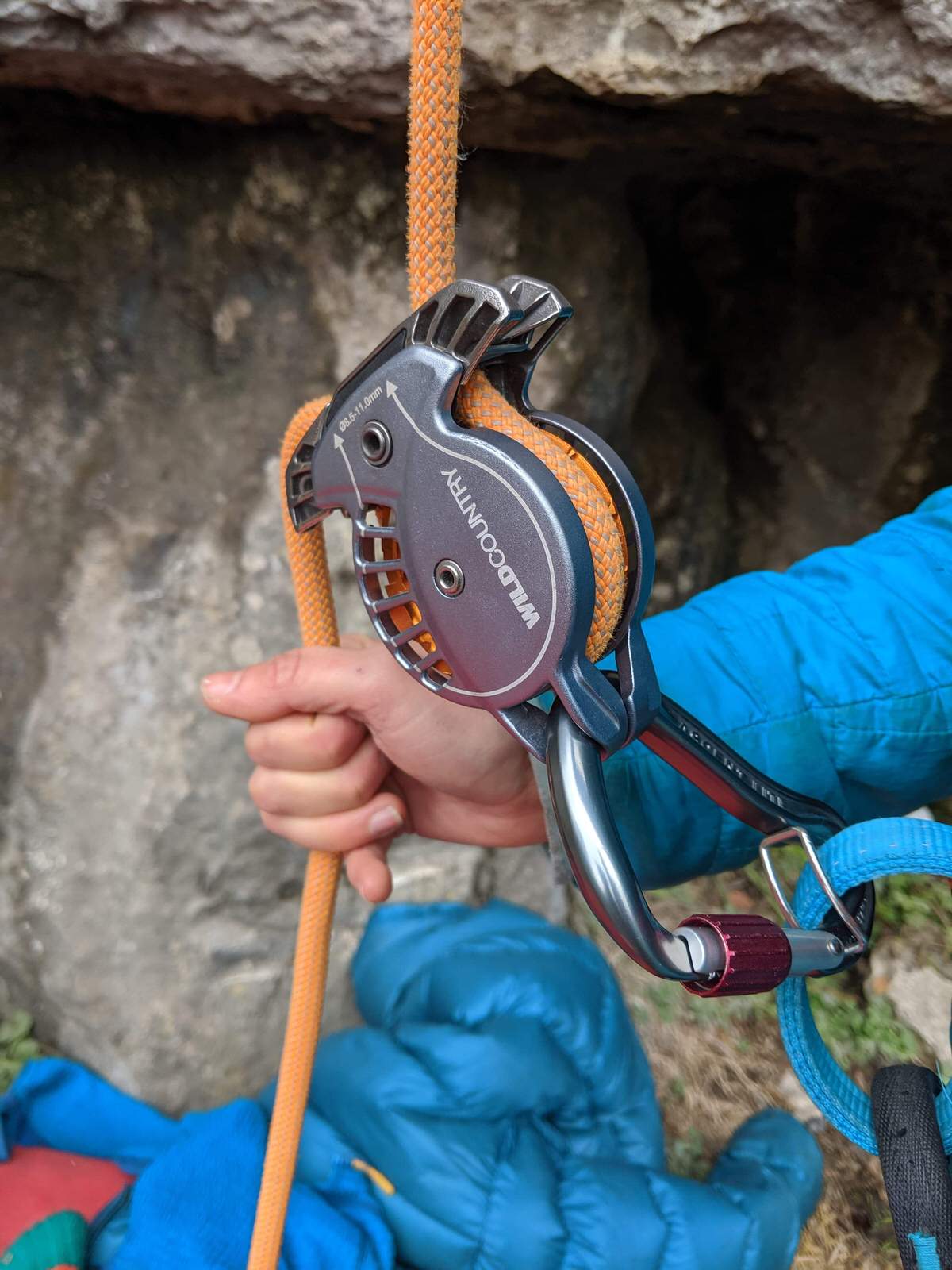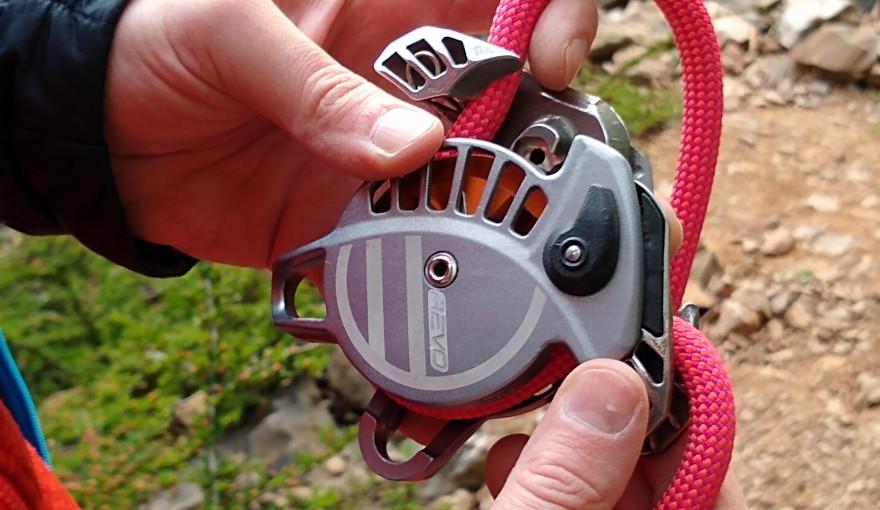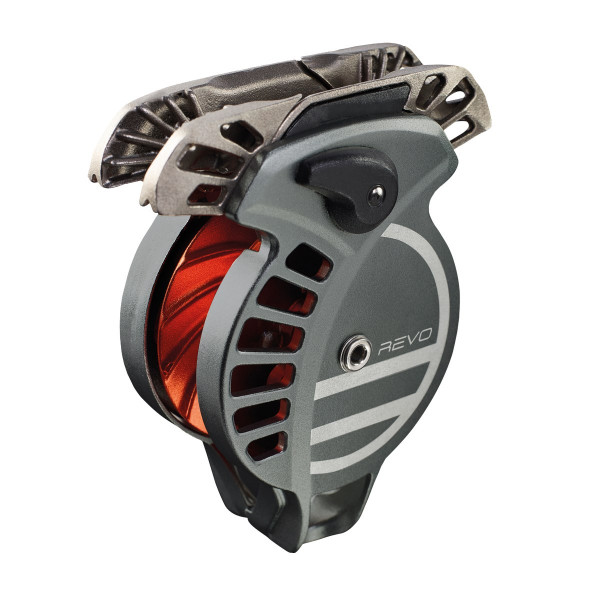Holly Rees gives us her thoughts on the Wild Country Revo belay device.
Nowadays, most people use an 'assisted locking' or 'braking' belay device when sport climbing. These types of devices help catch a falling climber in a reassuring way, and keep the belayer happier as they provide greater locking security. They arguably provide a safer system when belaying for long hours, or when working projects. There are many models available, but they all have slightly different ways of operation - I couldn't get on with one of the most common devices. I was excited to test the new Revo. Here are my thoughts.
This is the basic information about the Revo:
· The Revo has a 'brake assist' action on the rope. The rope runs through the device. A small lever within an inertia reel system engages with the rope, locking it in place, when the rope flows through the device at over 4 metres per second. The rope is then locked until it's actively released by the belayer.
· The brake assist function operates on the rope in both directions. This means it's a symmetrical device, and the inertia reel lever will engage with the rope either way round.
· There is no handle or lever on the Revo. Some devices lower the climber by engaging a lever; in a moment of panic, people can engage the lever and forget to release it. With the Revo, the lowering action is controlled by the device and rope. You cannot over-ride the locking mechanism, during belaying, or when lowering a climber.
Wild Country wanted to create a belay device which is easy to use, handles the rope smoothly without snatching or locking unexpectedly, and above all, is safe to use. Here are my thoughts of using the Revo in the real world.

A close-up of the Revo in action. Photo: Holly Rees
Loading the rope into the device is easy, thanks to the symmetrical design. The little catch to open the device is small and unobtrusive, so doesn’t get in the way. The belay device reassuringly clicks shut when the rope is loaded, and is compatible with any carabiner for attaching it to your harness. Some belay devices must orientate the 'climber' and 'belayer' ropes in the correct way, but the Revo avoids this. It's a more intuitive device, which encourages the same skills (keeping a hand on the 'dead/belayer' end of the rope), as when using a normal device.
Belaying with the Revo is easy. It's smooth to pay out slack or take in the rope. I'm a light climber. Using another belay device, I can't have much slack out, because I'll unintentionally give a soft catch to the climber - if they fall, their greater weight means I'll be pulled up to the first quickdraw and they might hit the ground; or we'll collide mid-air in a tangle of feet and heads, and I have to lower myself to the ground again. Inevitably, this means I might accidentally short-rope a climber (not give enough slack when they clip a quickdraw). I also have to pay out rope faster when they clip, and some devices might snatch the rope as I try to do this.
With the Revo, thanks to the inertia reel, paying out slack quickly is smooth, and there's no risk of me messing up. I can still belay safely.
Holding falls with this device is similar to any other device: holding the dead rope, lock your hands down, below the device. Thanks to the added help of the assisted braking, I feel pretty secure catching a fall.
Assisted braking - in the form of the inertia reel engaging with the rope - kicks in when the rope flows through the device at a speed greater than 4m/s. As a side note: viewed through a slow-motion camera, many belay devices will catch the rope in about 50 centimetres. When using a normal belay device, such as the Wild Country Pro Guide Lite, this distance can be slightly larger. If the climbers are roughly equal weight, this means the climber will fall slightly further, but usually have a softer catch. This can also be beneficial if belaying someone who is much lighter than you (a parent and child, for example). However, generally, climbers are similar weights and thus an assisted braking device is preferable, taking some of the work from the belayer.
But what does 'assisted braking' mean? How fast is 4m/s? How much rope will sneak through on the Revo, and how far would the climber fall? I wondered this too. So I tested it out (don’t worry, not for real). I just pulled the rope really quickly and hard. It let through very little, about half a metre maximum, but mostly around 30 centimetres! I’m pretty impressed with that, as I thought it would be a lot more - and the Revo worked every time. You unlock it by pulling the 'dead/belayer' end of the rope, and the device is reset to normal use again.
The Revo accommodates a wide range of rope diameters, from 8.5mm to 11mm. It works great when using a thick rope at the climbing wall, and on your onsight or redpoint attempt with a slimmer rope.

Loading the rope into the Revo. Photo: Rock + Run
The only thing the Revo isn't great for, is when your climber is working a route. This means the climber's full weight is on the rope, and they're resting (to recover, for example). When using the Revo, the inertia reel can still spin slightly as it's not engaged. This means the rope can slowly creep through the device. You have to keep your hand in the braking position (i.e. holding the rope under tension, 'locked off' in a downward position). You really have to hold the rope down hard to keep it there, and when the climber is taking long rests, your hand can get tired, and a bit stiff or cramped.
Overall, I find the Revo a really good belay device. I’d give it 8/10 - only for that extra effort you need to hold the rope locked when a climber is resting on the rope. It's not the best for working routes, but amazing for redpointing to ensure there's no accidental short-roping. It's also perfect for holding falls. From a safety perspective, you know the Revo will lock the rope and won't unintentionally release if the belayer has an accident, like passing out or getting hit by a falling rock.

The Revo in action. Photo: Holly Rees
The Revo is available on Wild Country's website, and further information is here.
Holly is sponsored by 3rd Rock and Beta Outdoor Sports (Tenaya, Wild Country, Lapis and Climb-on). Follow Holly on Instagram and read our interview after her ascent of Mecca.











